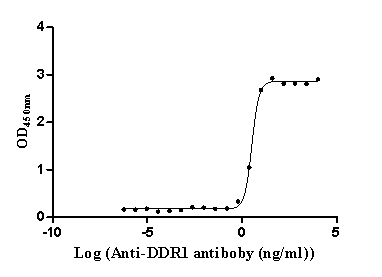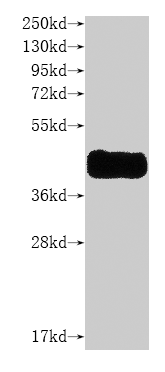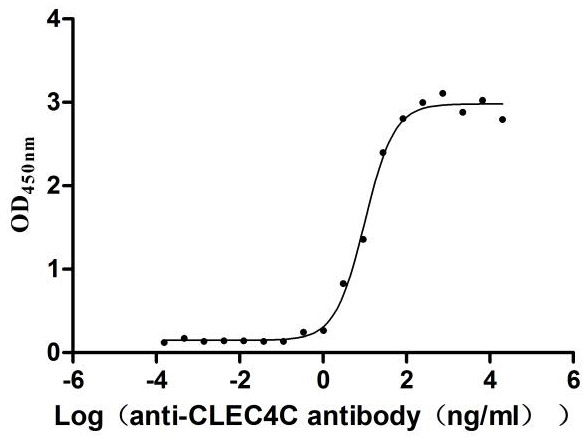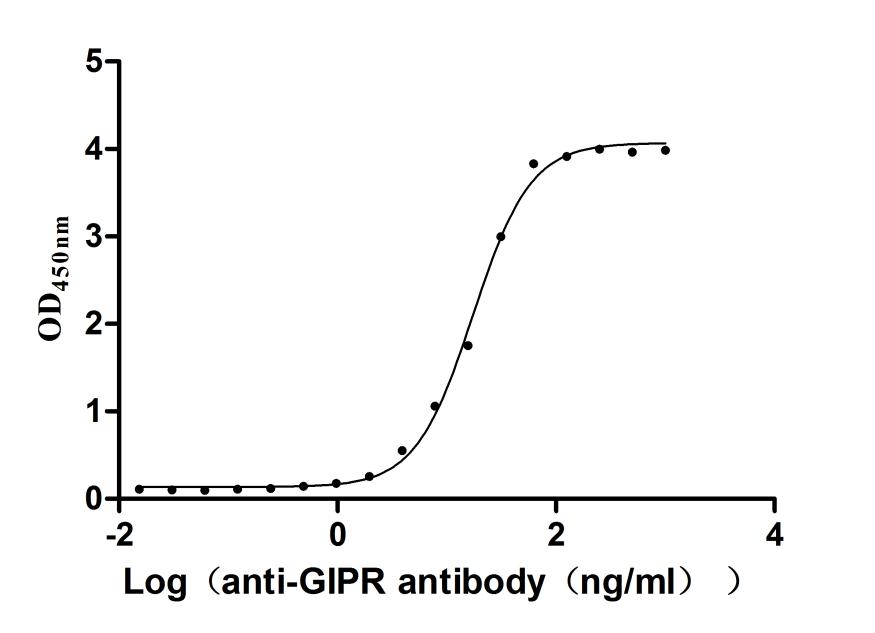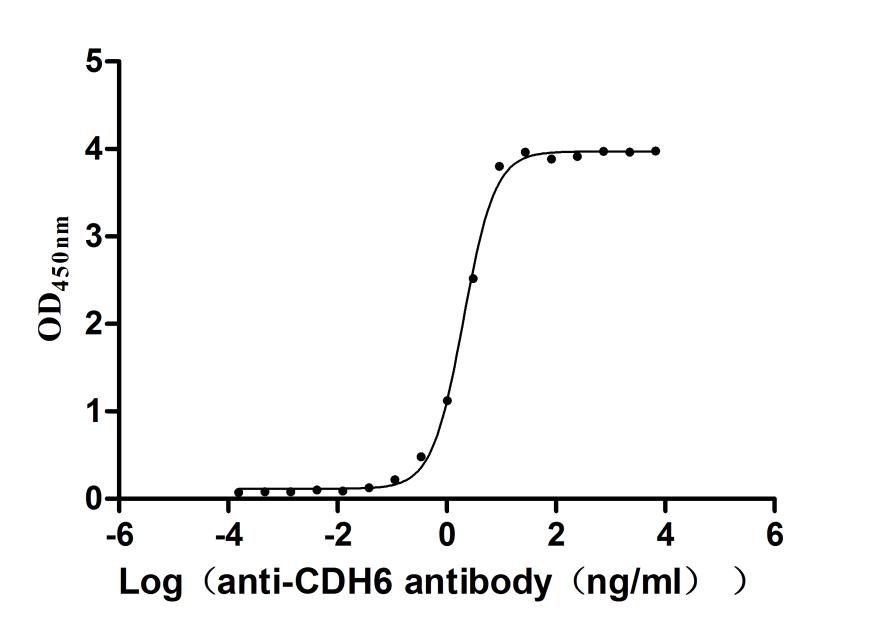Recombinant Mouse CD81 antigen (Cd81), partial
-
中文名稱:Recombinant Mouse CD81 antigen(Cd81),partial
-
貨號:CSB-YP004960MO
-
規格:
-
來源:Yeast
-
其他:
-
中文名稱:Recombinant Mouse CD81 antigen(Cd81),partial
-
貨號:CSB-EP004960MO-B
-
規格:
-
來源:E.coli
-
共軛:Avi-tag Biotinylated
E. coli biotin ligase (BirA) is highly specific in covalently attaching biotin to the 15 amino acid AviTag peptide. This recombinant protein was biotinylated in vivo by AviTag-BirA technology, which method is BriA catalyzes amide linkage between the biotin and the specific lysine of the AviTag.
-
其他:
-
中文名稱:Recombinant Mouse CD81 antigen(Cd81),partial
-
貨號:CSB-BP004960MO
-
規格:
-
來源:Baculovirus
-
其他:
-
中文名稱:Recombinant Mouse CD81 antigen(Cd81),partial
-
貨號:CSB-MP004960MO
-
規格:
-
來源:Mammalian cell
-
其他:
產品詳情
-
純度:>85% (SDS-PAGE)
-
基因名:
-
Uniprot No.:
-
別名:Cd81; Tapa1CD81 antigen; 26 kDa cell surface protein TAPA-1; Target of the antiproliferative antibody 1; CD antigen CD81
-
種屬:Mus musculus (Mouse)
-
蛋白長度:Partial
-
蛋白標簽:Tag?type?will?be?determined?during?the?manufacturing?process.
The tag type will be determined during production process. If you have specified tag type, please tell us and we will develop the specified tag preferentially. -
產品提供形式:Lyophilized powder
Note: We will preferentially ship the format that we have in stock, however, if you have any special requirement for the format, please remark your requirement when placing the order, we will prepare according to your demand. -
復溶:We recommend that this vial be briefly centrifuged prior to opening to bring the contents to the bottom. Please reconstitute protein in deionized sterile water to a concentration of 0.1-1.0 mg/mL.We recommend to add 5-50% of glycerol (final concentration) and aliquot for long-term storage at -20℃/-80℃. Our default final concentration of glycerol is 50%. Customers could use it as reference.
-
儲存條件:Store at -20°C/-80°C upon receipt, aliquoting is necessary for mutiple use. Avoid repeated freeze-thaw cycles.
-
保質期:The shelf life is related to many factors, storage state, buffer ingredients, storage temperature and the stability of the protein itself.
Generally, the shelf life of liquid form is 6 months at -20°C/-80°C. The shelf life of lyophilized form is 12 months at -20°C/-80°C. -
貨期:Delivery time may differ from different purchasing way or location, please kindly consult your local distributors for specific delivery time.Note: All of our proteins are default shipped with normal blue ice packs, if you request to ship with dry ice, please communicate with us in advance and extra fees will be charged.
-
注意事項:Repeated freezing and thawing is not recommended. Store working aliquots at 4°C for up to one week.
-
Datasheet :Please contact us to get it.
相關產品
靶點詳情
-
功能:Structural component of specialized membrane microdomains known as tetraspanin-enriched microdomains (TERMs), which act as platforms for receptor clustering and signaling. Essential for trafficking and compartmentalization of CD19 receptor on the cell surface of activated B cells. Upon initial encounter with a microbial pathogen, enables the assembly of CD19-CR2 and B cell receptor complexes at signaling TERMs, lowering the threshold dose of antigen required to trigger B cell clonal expansion and humoral immune response. In T cells, associates with CD4 or CD8 coreceptors and defines the maturation state of antigen-induced synapses with B cells. Facilitates localization of CD3 in these immune synapses, required for costimulation and sustained activation of T cells, preferentially triggering T helper type 2 immune response. Can act both as positive and negative regulator of homotypic or heterotypic cell-cell fusion processes. In myoblasts, associates with another tetraspanin CD9 in complex with PTGFRN and inhibits myotube fusion during muscle regeneration. In macrophages, associates with CD9 and beta-1 and beta-2 integrins, and prevents macrophage fusion into multinucleated giant cells specialized in ingesting complement-opsonized large particles. Also prevents the fusion between mononuclear cell progenitors into osteoclasts in charge of bone resorption. Positively regulates sperm-egg fusion and may be involved in the acrosome reaction. Regulates protein trafficking in intracellular compartments. In T cells, associates with dNTPase SAMHD1 and defines its subcellular location, enabling its degradation by the proteasome and thereby controlling intracellular dNTP levels. Also regulates integrin-dependent migration of macrophages, particularly relevant for inflammatory response in the lung.; (Microbial infection) Specifically required for Plasmodium yoelii infectivity of hepatocytes, controlling sporozoite entry in hepatocytes via the parasitophorous vacuole and subsequent parasite differentiation to exoerythrocytic forms.
-
基因功能參考文獻:
- The species-specific traits in CD9 and CD81 distribution during sperm maturation were compared between mice and humans. A mutual position of CD9/CD81 is shown in human spermatozoa in the acrosomal cap, however in mice, CD9 and CD81 occupy a distinct area. PMID: 29671763
- adoptive transfer of wild-type regulatory T cells into CD81-deficient mice was sufficient to promote tumor growth and metastasis; these findings suggested that CD81 modulates adaptive and innate immune responses PMID: 26329536
- CD81-Rac interaction exerts an important regulatory role on the innate and adaptive immunity against bacterial infection and suggests a role for CD81 in the development of novel therapeutic targets during infectious diseases. PMID: 25972472
- Plasmodium yoelii sporozoite rhoptry discharge occurs only in the presence of CD81, providing the first direct evidence for a role of CD81 during sporozoite productive invasion. PMID: 24798694
- In vitro myotubes lacking CD9P-1 or both CD9 and CD81 fuse with a higher frequency than normal myotubes PMID: 23575678
- Data suggest that GPC3 down-regulates hepatocyte proliferation by binding to hedgehog (HH) and down-regulating the HH signaling pathway and binding with CD81, thus making it unavailable to bind to Hhex and causing its nuclear translocation. PMID: 23665349
- CD81 interacts with the T cell receptor to suppress signaling. PMID: 23226274
- CD81 promotes the microvillus formation and/or extension while tetraspanin CD82 inhibits these events. In addition, CD81 enhances the outward bending of the plasma membrane while CD82 inhibits it. PMID: 22079629
- Self-renewing hematopoietic stem cells express CD81 during stress-induced proliferation. PMID: 21931533
- CD81 is required for the formation of actin membrane protrusions via Rac1 activation in adhesion-dependent immune cell migration. PMID: 21677313
- data indicate that CD81 plays a significant role in the final stages of RPE development, controlling cell number and overall developmental pattern PMID: 20882409
- CD81 gene is maternally imprinted, with preferential expression from the paternal allele. PMID: 20579434
- CD81 plays a negative role in B cell activation in vitro and in vivo. PMID: 19737782
- CD81 expression by T cells is critical for their induction of IL-4 synthesis by B cells PMID: 11978781
- Infertility of CD9-deficient mouse eggs is reversed by mouse CD81 PMID: 12086470
- the role of CD81 in the regulation of astrocyte and microglial number, perhaps by regulating cell proliferation by a contact inhibition-dependent mechanism. PMID: 12357429
- Data show that CD81, a putative receptor for hepatitis C virus, is required on hepatocytes for human Plasmodium falciparum and rodent Plasmodium yoelii sporozoite infectivity. PMID: 12483205
- CD81 affects expression of its associated partner CD19 beginning at a B-cell postendoplasmic reticulum compartment where CD81 is necessary for normal trafficking or for surface membrane stability of CD19. PMID: 14530327
- CD81 strengthens multivalent VLA-4 contacts within subsecond integrin occupancy without altering intrinsic adhesive properties to low density ligand. CD81 facilitates both VLA-4-mediated leukocyte rolling and arrest on VCAM-1 PMID: 14532283
- CD81 is required for the association of the B cell antigen receptor and the CD19/CD21 complex with lipid rafts and for enhanced signaling from rafts upon coligation. PMID: 14688345
- CD81 signaling events could be mediated by 14-3-3 adapter proteins, and these signals may be dependent on cellular redox PMID: 14966136
- CD9 and CD81 play complementary roles in sperm-egg fusion PMID: 16380109
- CD81 plays multiple roles in the processing, intracellular trafficking, and membrane functions of CD19. PMID: 16449649
- Murine CD81 does not mediate hepatitis C virus pseudoparticle entry when transfected into human HepG2 tumor cells. PMID: 16641285
- Disruption of the mouse CD81 gene led to a reduction in the fecundity of female mice, and CD81-/- eggs had impaired ability to fuse with sperm. PMID: 17290409
- We conclude that CD81 represents a potential therapeutic target to interfere with leukocyte infiltration and ameliorate inflammatory neurological damage in MS. PMID: 18586096
- tetraspanins CD9 and CD81 regulate cell motility and protease production of macrophages and that their dysfunction may underlie the progression of COPD PMID: 18662991
- CD81 is indispensable for an authentic in vivo hepatitis C virus infection. PMID: 19030166
- CD81 potentially plays a role in macrophage cell line growth regulation. PMID: 19184252
- Inactivation of CD81 by homologous recombination can increase astrocyte and microglial cell proliferation and can lead to anomalously large brain size (30% larger than normal). The effect depends on genetic background. PMID: 12357429
顯示更多
收起更多
-
亞細胞定位:Cell membrane; Multi-pass membrane protein. Basolateral cell membrane; Multi-pass membrane protein.
-
蛋白家族:Tetraspanin (TM4SF) family
-
組織特異性:Expressed in oocytes (at protein level). Highly expressed in granulosa cells. Expressed in skeletal muscle mainly in endothelial cells of endomysial capillaries, in satellite cells and myoblasts (at protein level). Expressed in hepatocytes (at protein lev
-
數據庫鏈接:
Most popular with customers
-
Recombinant Human Tumor necrosis factor ligand superfamily member 14 (TNFSF14), partial (Active)
Express system: Mammalian cell
Species: Homo sapiens (Human)
-
Recombinant Human Angiopoietin-2 (ANGPT2) (Active)
Express system: Mammalian cell
Species: Homo sapiens (Human)
-
Recombinant Mouse Tyrosine-protein kinase Mer (Mertk), partial (Active)
Express system: Mammalian cell
Species: Mus musculus (Mouse)
-
Recombinant Human Epithelial discoidin domain-containing receptor 1 (DDR1), partial (Active)
Express system: Mammalian cell
Species: Homo sapiens (Human)
-
Recombinant Human C-C chemokine receptor type 8 (CCR8)-VLPs (Active)
Express system: Mammalian cell
Species: Homo sapiens (Human)
-
Recombinant Human C-type lectin domain family 4 member C (CLEC4C), partial (Active)
Express system: Mammalian cell
Species: Homo sapiens (Human)
-
Recombinant Human Gastric inhibitory polypeptide receptor(GIPR),partial (Active)
Express system: Mammalian cell
Species: Homo sapiens (Human)
-
Recombinant Mouse Cadherin-6(Cdh6),partial (Active)
Express system: Mammalian cell
Species: Mus musculus (Mouse)


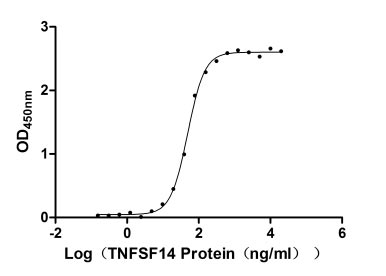
-AC1.jpg)

